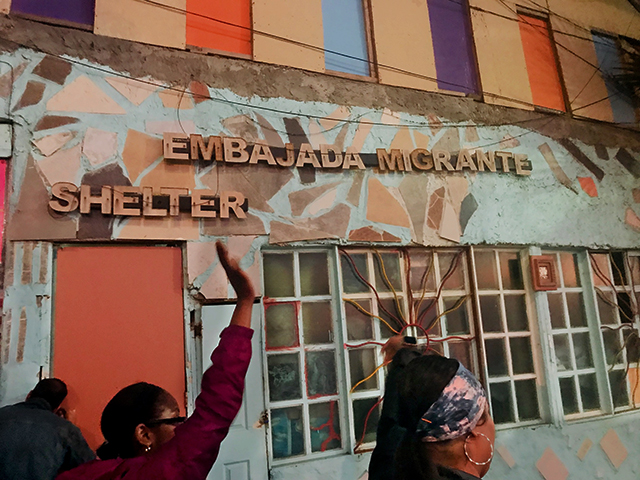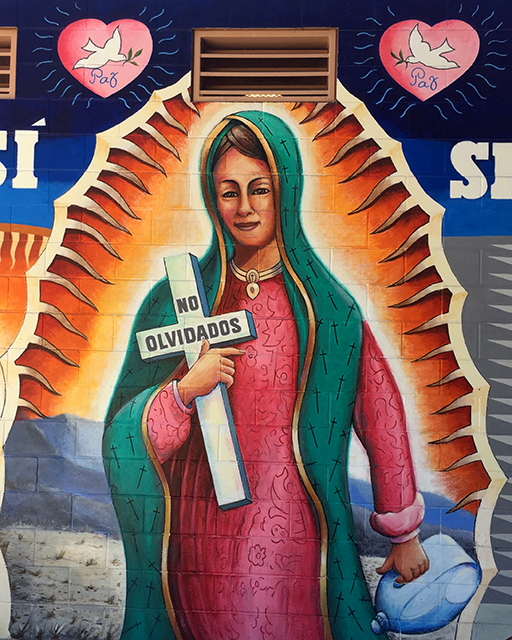Border Immersion Reflection
By Zahra Ahmed, Assistant Professor of Politics
In July, eight professors from Saint Mary’s College traveled to the San Diego – Tijuana border on a fact-finding mission to learn about the migration crisis on the border first-hand. Over the course of five days, the group met with multiple organizations and had the opportunity to meet with migrants themselves at several shelters. This project lives out Saint Mary’s College’s commitment to social justice, providing the opportunity for its faculty to go deep into issues of contemporary importance. Four of the participants have written short reflections about their experience on the border, which The Stansbury Forum will feature over the next few weeks. Here is the first one.

When I visited the US-Mexico border as part of St. Mary’s College’s Migrant Lives immersion program, I expected to encounter suffering and chaos. Given the actions of the current presidential administration, which are designed to denigrate and dehumanize immigrants, I expected the migrants I encountered and the people who work with them to be immobilized by the repeating and continuing traumas they have encountered. The horrible stereotypes perpetuated by the current President and his underlings, the violence perpetuated by the state as well as individuals acting out their hatred, the inhumane family separation policy which continues to be enforced despite claims to the contrary – I expected the knowledge of these conditions to permeate the lives and experiences of the migrants I met. However, that was not the case. One of my lasting impressions from this experience was actually a feeling that migrants and refugees as well as their allies and advocates are stronger and more resilient than I gave them credit for.
The migrants I talked with in the camps of the Central Valley and in the shelters in Tijuana had experienced multiple traumas ranging from family members hurt or killed in their home countries to deportation and separation from loved ones in the U.S. The migrants in the Central Valley live hard lives, working essentially from sun up to sun down. The refugees in Tijuana had either been deported from the U.S. or they had recently made it to Tijuana as they fled violence and political repression in their home countries. Yet everyone I encountered had quick and easy smiles, optimistic spirits, and a belief that we can create a more just society. This was especially true of those who work to help migrants and refugees on the Mexico side of the border.
“She spoke about the increasing number of migrant and refugee men who, due to family separation policies and other factors, are now travelling alone with their children”
When we visited Casa Del Migrante (a men’s shelter in Tijuana) and Centro Madre Asunta (a women’s shelter right next door), the two women we met who run these facilities showed a clear and strong commitment to addressing the needs of their communities. Valeria, the administrator at Casa Del Migrante, told us that they had recently changed their policies to allow men travelling with children to stay in the shelter. She spoke about the increasing number of migrant and refugee men who, due to family separation policies and other factors, are now travelling alone with their children. Although this change drastically increased the number of migrants and refugees they needed to serve, they recognized that these men were in need of resources, so they adapted the facility to meet the needs of men and children.
Both Valeria and Hermana Salome, the Catholic Sister who runs Centro Madre Asunta, told us that the local government had recently made drastic cuts to the social safety net system, which affected all of the shelters in Tijuana. Many shelters had to close their doors. But Valeria and Hermana Salome also told us that other shelters responded to the cuts by relying more on one another and forming networks to share resources and advocate to restore the funding to the government’s budget. Their passion and their commitment to working with those who came to their doors needing help in the face of diminished state support was inspirational to me.

I also felt connected to the mission and the work of the Border Angels, a non-profit organization with chapters in both the U.S. and Mexico. I was introduced to this organization through the Migrant Lives immersion program, and I came to admire the organization’s focus on migrant rights, immigration reform, and prevention of deaths along the U.S.-Mexico border. During our trip, we talked with the Co-Directors of their Tijuana office, Hugo and Gaba, who shared the beautiful and painful experiences they’d had while attempting to help migrants and refugees. Gaba told us about her amazing photography project that she created while living with refugees for several months at one of the camps. As she talked, she showed us photos of some of the people she lived with intending to document their stories. Some of the people in the photos had died, either from violence in the camps or from violence when they returned to their home countries. I was honored to listen to Gaba’s reflections about them and her experience in the camps.
Hugo also shared stories of his work helping refugees and deportees. When they deport individuals, the U.S. government drops people off in the middle of the night at an undisclosed location. They are dropped off with no clothes other than what they are wearing, no supplies, and no connections with any social support systems to help them survive and figure out their next steps. Hugo told us how he followed the busses to find out where deportees were being dropped off and then connected with them to share information about services and resources available to them. He told us about being picked up by the police and beaten because of his work helping and advocating for migrants and refugees. He even mentioned that he’d had to go to the hospital after one of the beatings and it took him several months to recover. He told us that he is still traumatized and he feels fear and anxiety now whenever he sees the police. And yet, with his next breath, he told us about how he plans to expand the resources offered by the Border Angels by creating a shelter as well as a social entrepreneurship in the form of a cafe where migrants and refugees can make music, create spoken word poetry, photography, and other art forms as a means of healing and advocacy. Gaba termed this activity “artivism” and both she and Hugo seemed energized by the thought of feeding creativity among the migrant population.
My experience with the Migrant Lives border immersion program was transformative because it allowed me to see first-hand what migrants and refugees are enduring in California’s Central Valley as well as at the US-Mexico border. It also served as a reminder that all human beings are deserving of love, respect, and to be treated with dignity. Valeria, Hermana Salome, Hugo, and Gaba showed me that, as long as we remember this truth and commit to demonstrating it in whatever professions or fields we represent, we will transcend this crisis with our morals and our humanity intact.
.